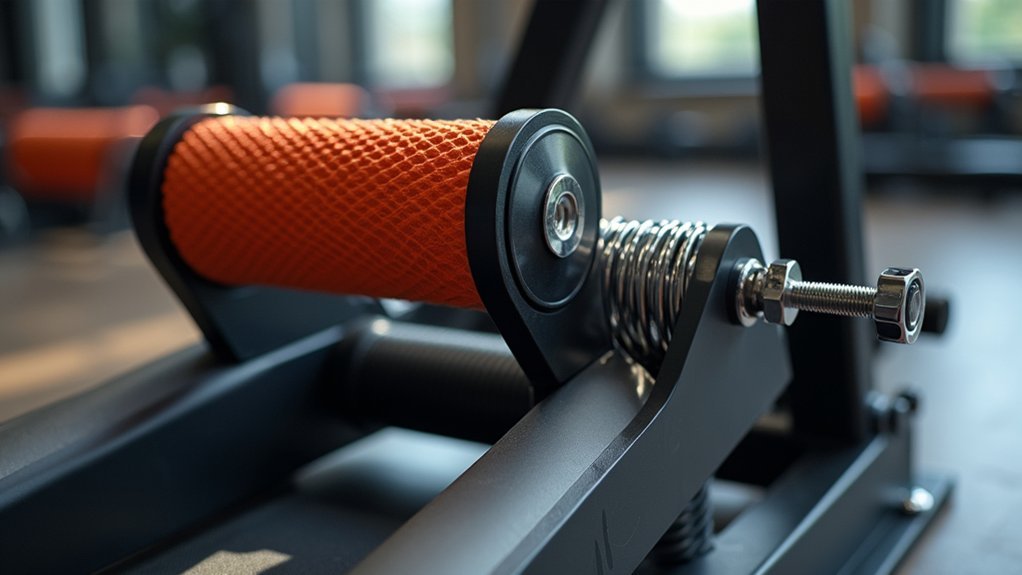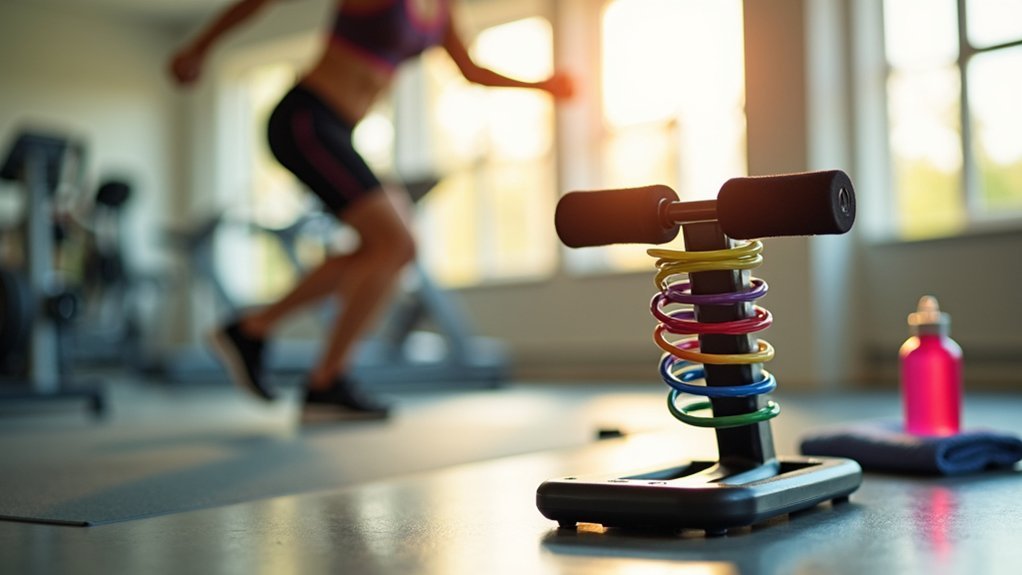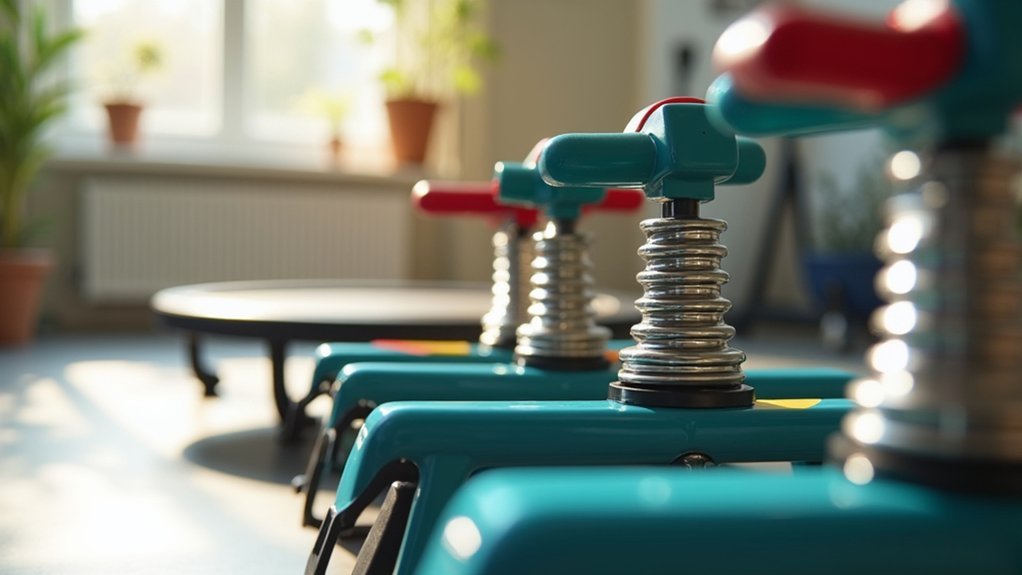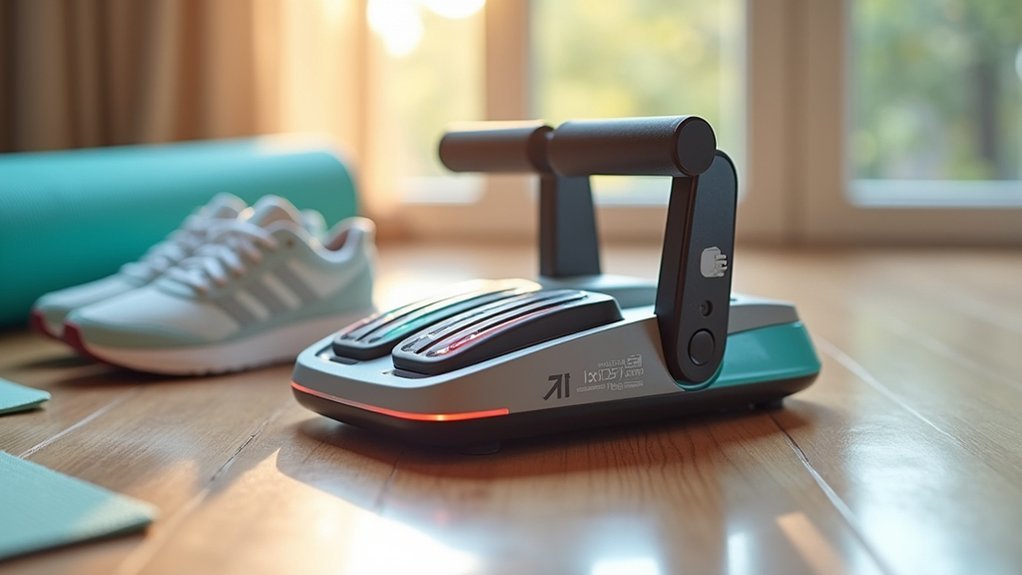Modern spring tension adjustable mini-exercisers offer customizable workouts for all fitness levels. Premium models feature high-grade steel springs or bungee systems that reduce joint impact while maximizing muscle engagement. You’ll find options like JumpSport’s EnduroLast™ cords and Bellicon’s bungee system providing superior durability and bounce quality. Start with lower tension as a beginner, then increase as your strength improves. The right tension setting can transform your workout efficiency, protect your joints, and dramatically improve your rebounding experience.
Understanding Spring Tension Technology in Modern Rebounders

Five critical components work together to create the perfect bounce in modern rebounders. High-grade steel springs connect to a tubular frame through non-elastic fasteners, with tension rods and specialized mat attachments completing this precision-engineered system.
Your rebounder’s frame actually bows slightly by design, compensating for tension loss as springs naturally fatigue over time. This ingenious deflection mechanism guarantees consistent performance throughout the equipment’s lifespan. Using tapered steel springs can enhance both durability and bounce quality compared to standard tube springs.
The spring tension directly impacts your workout experience—tighter configurations deliver faster aerobic response while looser setups reduce joint stress during gentler sessions.
When maintaining your unit, remember to lubricate spring ends with Vaseline or coconut oil to prevent squeaking, and always replace springs when they’ve elongated beyond 5-10% to maintain peak rebound efficiency.
Top 5 Spring Tension Adjustable Rebounders Worth Your Investment
When choosing a rebounder with adjustable spring tension, you’ll find significant differences between premium models like the Cellerciser and budget options such as the HOMCOM.
Premium rebounders typically offer more sophisticated tension adjustment systems, allowing you to customize resistance for different workout intensities and fitness goals.
Whether you’re considering the JumpSport 350’s exceptional stability or the Fit Bounce Pro II’s quieter bungee system, understanding these advanced tension features will help you select the right mini-trampoline for your specific needs. The choice between springs or bungees will affect your workout experience, with bungee cords providing a quieter and lower-impact bounce while springs offer a firmer, more responsive surface.
Premium vs. Budget Options
Investing in the right rebounder can make all the difference between a sustainable fitness routine and abandoned equipment collecting dust.
Premium spring rebounders like the Maximus Pro and JumpSport models offer superior durability with thicker-gauge steel springs that maintain tension for years, while budget options under $150 often fail within months of intense use.
Consider these key differences:
- Premium models absorb shock better with advanced spring calibration, reducing joint strain compared to the harsh bounce of budget alternatives.
- High-end rebounders support heavier weight limits (250-300+ lbs) and come with 5-10 year warranties versus 1-2 years for budget versions.
- Premium options provide more stable, quieter workouts with textured, non-slip surfaces ideal for high-intensity training.
For medical conditions such as osteo-arthritis and lymphoedema, experts recommend bungee sprung rebounders for their softer, more comfortable bounce experience.
Advanced Tension Features
Serious rebounding enthusiasts understand that customizable tension is what transforms a basic mini-trampoline into a versatile fitness tool capable of accommodating different workout styles and user weights.
| Brand | Tension Technology | Key Benefit |
|---|---|---|
| JumpSport | EnduroLast™ cords | 2x stretch capacity for millions of bounces |
| Bellicon | Bungee system | Reduced joint impact vs. spring models |
| BCAN | Removable bungees | DIY firmness customization |
| Leaps & Rebounds | Spring-based | Cost-effective tension control |
| Various | Tool-free mechanisms | On-the-fly adjustability |
The most advanced models offer tension customization without sacrificing stability. JumpSport’s arched-leg design prevents tipping during directional movements, while Bellicon’s multiple tension kits let you modify resistance independently. For budget-conscious buyers, BCAN’s removable bungee system provides comparable bounce to premium models through simple DIY adjustments. User testing confirms that JumpSport’s adjustable tension allows for personalization based on individual preferences, making it especially suitable for older participants.
How Spring Tension Affects Your Rebounding Workout Intensity

Spring tension on your rebounder directly influences how hard your muscles work during each bounce.
You’ll notice increased resistance challenges your legs, core, and stabilizing muscles more intensely as you adjust to higher tension settings.
Fine-tuning this resistance allows you to gradually progress your workouts, targeting specific muscle groups while controlling the overall intensity of your rebounding sessions. While many shoppers focus on rebounder diameter, tension impacts significantly more than size when it comes to your overall rebounding experience and workout effectiveness.
Resistance Levels Matter
When you adjust the tension on your mini-exerciser, you’re actually customizing the entire workout experience. Higher spring tension increases rebound force, requiring your muscles to work harder to absorb impact. This customization allows you to tailor sessions for cardio with low-medium tension or strength training with higher settings. For optimal safety and effectiveness, consider working with experienced physical therapists who can guide proper form and tension selection for your specific needs.
Your fitness goals should determine your tension selection:
- Low tension facilitates rehabilitation exercises and improves range of motion for those recovering from injuries.
- Medium tension optimizes bone density improvements while balancing joint safety and musculoskeletal loading.
- High tension maximizes plyometric benefits by enhancing rapid force production, ideal for athletic performance.
As you progress, gradually increasing tension prevents overuse injuries while ensuring your workouts remain challenging. The right resistance level transforms your mini-exerciser from simple equipment into a versatile training tool.
Fine-Tuning Muscle Engagement
Your ability to precisely target specific muscle groups depends largely on how you adjust your mini-exerciser’s spring tension. Higher tension settings increase ground reaction forces, recruiting more muscle fibers in your quadriceps, hamstrings, and glutes during both propulsion and landing phases.
For upper body focus, moderate tension improves rotator cuff and scapular stability as you perform arm movements against variable rebound forces. This can be especially effective for engaging various muscles, including abdominal and deep back muscles simultaneously.
When rehabilitating, choose lower tensions to minimize joint stress while still promoting blood flow and gentle muscle activation.
The biomechanics shift markedly with each adjustment—stiffer springs require stronger concentric contractions and enhance eccentric loading during landing, improving your muscle’s braking strength.
Meanwhile, softer settings emphasize calf engagement and increase rebound frequency, perfect for endurance work or active recovery between high-intensity intervals.
Beginner to Advanced: Selecting the Right Spring Tension for Your Fitness Level
How effectively you progress on a mini-exerciser depends largely on choosing the right spring tension for your current fitness level. If you’re a beginner, start with lower tension to build proper form and prevent injury, gradually increasing as your strength improves. Finding the resistance sweet spot requires practice and attention to your body’s signals, similar to adjusting resistance on a cycling bike.
Advanced users will benefit from higher resistance settings that challenge muscles and support power training.
Consider these factors when selecting your ideal tension:
- Your fitness goals – endurance training requires moderate tension while strength building needs higher resistance
- Physical factors – body weight, age, and any injury recovery needs will influence best settings
- Workout intensity – adjust tension to match the intensity level you’re targeting for each session
Properly adjusted tension maintains safety while maximizing your results through customized resistance that grows with your abilities.
Maintenance and Longevity of Spring-Based Rebounders

To maximize the lifespan of your spring-based rebounder, regular maintenance is essential for both safety and performance. Inspect springs frequently for damage and replace them promptly. Lubricate metal contact points with grease rather than oil to prevent dripping and rust formation. Applying vaseline or coconut oil to springs can significantly reduce noise during workouts.
| Maintenance Task | Frequency | Benefits |
|---|---|---|
| Spring inspection | Monthly | Prevents injuries and extends lifespan |
| Frame cleaning | After use | Prevents corrosion and buildup |
| Spring lubrication | Quarterly | Reduces noise and prevents rust |
Proper storage is equally important—keep your rebounder in a dry location and use weather-resistant covers during off-seasons. Don’t exceed recommended weight limits, as this can accelerate spring fatigue. When folding your rebounder, handle the legs carefully without pulling on springs to avoid damaging the mechanism.
The Science Behind Impact Absorption in Quality Spring Systems
While proper maintenance extends your rebounder’s life, understanding the underlying science of its spring system reveals why quality matters in the first place.
Quality springs convert kinetic energy (your bouncing motion) into potential energy, reducing impact forces on your joints and the frame. This conversion follows Hooke’s Law (F = kx), where spring rate determines bounce responsiveness.
When you exercise on a rebounder, you’re benefiting from:
- Energy conversion – Springs absorb impact energy during compression before returning it during rebound
- Material selection – High-grade alloy steels resist fatigue during repeated impacts
- Damping characteristics – Quality systems minimize unwanted oscillations by dissipating excess energy as heat
The spring system’s design directly affects your workout efficiency, comfort, and the rebounder’s durability over thousands of bounces. The stiffness of springs used in rebounders is carefully calibrated so that softer springs deform more under your weight, providing a gentler experience for beginners or rehabilitation purposes.
Comparing Bungee vs. Traditional Spring Tension Mechanisms
When choosing a rebounder, you’ll face a fundamental decision between bungee and traditional spring tension mechanisms. Each offers distinct advantages for your home workouts.
Bungee systems provide a slower, softer bounce that’s gentler on joints and considerably quieter—perfect if you’re exercising in apartments or shared spaces. They’re also adjustable and generally safer, eliminating risks of metal entanglements. They typically feature larger bounce spaces for greater comfort during your workout sessions.
Enjoy gentle, silent workouts with bungee rebounders—the apartment-friendly solution for safe, low-impact exercise.
Traditional springs deliver a quicker bounce response, making them better suited for high-intensity workouts and faster-paced exercise routines. They typically engage muscles more dynamically but require more maintenance as springs need occasional tightening or replacement.
Your choice should align with your fitness goals: bungees excel for beginners and low-impact needs, while springs better serve those seeking vigorous cardio workouts with immediate rebound action.
Customizing Your Workout: Adjustable Tension Settings for Different Exercise Goals
Modern rebounders offer more than just different spring types—they feature adjustable tension settings that transform your mini-trampoline into a versatile fitness tool.
You’ll find stepless micro-adjustments that enable precise resistance levels, allowing you to gradually progress as your fitness improves.
Match your tension settings to specific workout goals:
- Low resistance improves circulation and passive mobility—ideal if you’re sedentary or recovering from injury
- Moderate resistance enhances calorie burn during longer sessions, perfect for under-desk cycling
- High resistance strengthens leg muscles through dynamic loading, greatly improving stamina
When adjusting tension, remember that textured, non-slip pedals provide stability during intense workouts while digital displays help track your progress. The Smart Mini Exercise Bike features silent operation with its friction belt-drive system, ensuring your workouts won’t disturb others.
You can quickly modify resistance without interrupting your session, making it easy to incorporate interval training or simulate hill climbs.
Frequently Asked Questions
Can People With Joint Pain Safely Use Spring Tension Rebounders?
Yes, you can safely use rebounders with joint pain by selecting models with adjustable spring tension, starting slowly, using proper form, and keeping bounces gentle. Consult your doctor first if you have severe conditions.
How Often Should Springs Be Replaced on a Mini-Exerciser?
You should replace mini-exerciser springs when you notice visible wear, reduced tension, unusual noises, or unstable pedals. With proper maintenance, they’ll last 1-3 years depending on your usage frequency and environmental conditions.
Are Rebounders Suitable for Children or Pregnant Women?
Rebounders aren’t recommended for pregnant women due to fall risks and hormonal changes affecting balance. Children shouldn’t use them either, as they pose significant injury risks despite adult supervision. Consider safer alternatives for both groups.
Do Spring Tension Rebounders Require Assembly or Come Pre-Assembled?
Most spring tension rebounders require assembly. You’ll need to attach springs to the frame using provided tools like T-hooks. Pre-assembled options exist but they’re less common and typically cost more than DIY models.
What’s the Weight Capacity for Most Spring Tension Mini-Exercisers?
Most spring tension mini-exercisers support up to 220 lbs (100 kg), though capacities vary by design and materials. You’ll want to check your specific model’s specifications to verify it’s appropriate for your weight.
In Summary
With the right adjustable spring tension mini-exerciser, you’ll transform your home workouts forever. Whether you’re a beginner starting with gentle tension or an athlete pushing for maximum resistance, these versatile rebounders adapt to your changing fitness journey. Don’t underestimate proper maintenance—it’s essential for longevity. Remember, your perfect bounce isn’t just about comfort—it’s about achieving your specific fitness goals with every spring-loaded movement.





Leave a Reply